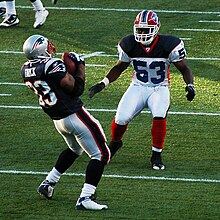This article needs additional citations for verification. (August 2023) |

A fair catch is a feature of American football and several other codes of football, in which a player attempting to catch a ball kicked by the opposing team – either on a kickoff or punt – is entitled to catch the ball without interference from any member of the kicking team.[1] A player, usually a return specialist, wishing to make a fair catch signals his intent by extending one arm above his head and waving it while the kicked ball is in flight. A ball caught in this manner becomes dead once caught, i.e., the player catching the ball is not entitled to advance the ball, and the receiving team begins its drive at the spot where the ball was caught.
Since 2018, the National Collegiate Athletic Association (NCAA) has had a touchback provision where fair catches caught anywhere inside the 25-yard line on a kickoff are placed at the 25 for the ensuing drive. In 2023, the National Football League (NFL) adopted the same rule in order to reduce the frequency of player injuries on kickoffs. Under NFL and National Federation of State High School Associations (NFHS) rules, a team awarded a fair catch is also entitled to attempt a fair catch kick from the spot of the catch; however, this is rarely done.
The main reason for a fair catch is to protect the receiver. Because the receiver has to direct his attention toward catching the airborne ball, he cannot focus on opponents running towards him and is usually not in a position to protect himself immediately when he catches the ball, and is therefore particularly vulnerable to injury from being hit by an opponent. He is also at risk for fumbling or muffing the kicked ball if the punter intentionally makes a high short kick to allow defenders time to hit the receiver. A second reason for a fair catch, on a punted ball, is to prevent the ball from rolling toward the receiving team's goal and being downed deep in the team's own territory.